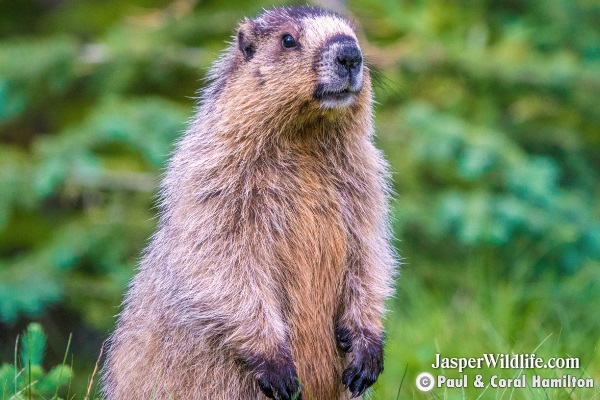(Marmota flaviventris) MARMOT

How large is Jasper Alberta's Marmot?
- Mass: usually 2 - 5 kg
Length: to 28 in. (72 cm) - Wildlife living area: taiga, temperate forest & rainforest, temperate grassland
Status: no special status.
Range:The yellow-bellied marmot ranges from southwestern Canada throughout the western United States. - Yellow-bellied marmots have distinct yellow speckles on the sides of their necks, white between their eyes, yellow to red-yellow bellies and yellow-brown to tan, straight hair with white tips. Male marmots are heavier than females. The length of the body is 45-57 cm while the tail is 13-22 cm long. They also have a thumb stump with a nail.
- Melanism is widely found south of the Rocky Mountains.
Where do Marmots live?
Hoary Marmot "Whistler" Nursing Her Babies
Hoary marmots live near the tree line on slopes with grasses and forbs to eat and rocky areas for cover. Hoary marmots are diurnal and herbivorous, subsisting on leaves, flowers, grasses, and sedges. Predators include golden eagles, grizzly and black bears, wolverines, coyotes, red foxes, lynxes, wolves, and cougars.
Hoary Marmot Reproduction
Hoary marmots breed shortly after, or even before, their emergence from hibernation burrows in May and in some areas as early as February. Gestation lasts 25 to 30 days, so the litter of two to five young is born between late May and mid-June. The young "Whistlers" emerge from their birth den at three to four weeks of age, by which time they have a full coat of fur and are already beginning to be weaned. Subadults initially remain with their birth colony, but typically leave at two years of age, becoming fully sexually mature the following year.

Details on the Jasper Marmot
The yellow-bellied marmot generally occupies open habitats such as steppes, alpine meadows, pastures, gravel-covered fields and forest edge. These marmots prefer to construct their burrows on open, grassy or herb-covered slopes. They generally occupy elevations of about 2,000 m but can be found at elevations up to 4,100 m in the Rocky Mountains.
Marmota flaviventris has 11 subspecies that populate extremely different climatic zones in western North America.

Marmot Tracks
